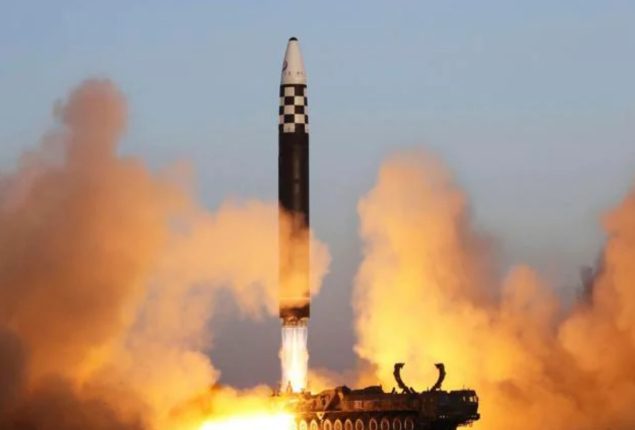North Korea fully pauses its military alliance with South Korea
North Korea fully paused its military alliance with South Korea. Pyongyang claimed...

North Korea Launches Most Powerful Long-Range Missile after South Korea-US Meeting
North Korea has reportedly launched its most sophisticated long-range missile, as stated by South Korean authorities, in defiance of UN restrictions.
The intercontinental ballistic missile (ICBM) was fired and landed west of Hokkaido in Japan, prompting swift condemnation from Western nations.
This provocative action follows a recent meeting between South Korean and US defense officials to discuss updated plans on how to respond to potential nuclear threats from North Korea.
Pyongyang had vowed to take “more offensive countermeasures” in response.
On Monday morning at around 08:24 local time in Pyongyang, North Korea launched a long-range missile.
Reports indicate that the missile, which traveled for 73 minutes and covered approximately 1,000 km (621 miles), was the country’s fifth successful launch of an intercontinental ballistic missile (ICBM) this year.
ICBMs can reach the North American continent. The missile test received swift condemnation from South Korea, Japan, and the United States.
Officials from these countries emphasized that the launch violated UN Security Council resolutions, heightening tensions on the Korean peninsula and undermining regional security.
The recent missile launch comes after North Korea’s successful deployment of a spy satellite into orbit last month, also in violation of UN sanctions.
In response, South Korea partially suspended a military agreement with North Korea, designed to limit military activities along the border and reduce the risk of conflicts.
Following the suspension, North Korea withdrew entirely from the agreement and has since armed soldiers in previously unarmed areas of the Demilitarized Zone, separating its territory from South Korea.
Last week, South Korea’s national security advisor, Kim Tae-hyo, anticipated that North Korea might launch an ICBM at some point in December.
On Monday, South Korean national security officials confirmed that the intercontinental ballistic missile (ICBM) launched by North Korea was a solid-fuel missile.
Unlike liquid-fuel missiles, solid-fuel missiles can be fired with less warning since they don’t require fueling prior to launch.
North Korea had previously tested its Hwasong-18 missile in July, following a successful first flight in April.
The country is also working on developing a new solid-fuel medium-range ballistic missile, claiming last month to have successfully tested the engine, though the missile itself had not yet been launched.
As North Korea continues to enhance its nuclear weapons arsenal, South Korea and the United States are intensifying their defense efforts in the region.
In a meeting held in Washington on Friday, officials updated contingency plans for responding to a potential North Korean nuclear attack. Both nations also agreed to incorporate the use of nuclear weapons in their military exercises scheduled for next summer.
North Korea is strengthening its connections with China and Russia. On Monday, North Korean officials had a meeting with Chinese Foreign Minister Wang Yi in Beijing.
Despite swift condemnation of Monday’s missile launch from various countries, Wang Yi voiced China’s support for Pyongyang. He emphasized the enduring support and trust between China and North Korea, as per a statement from the Chinese foreign ministry.
Since May 2022, North Korea has been able to conduct weapon tests with limited consequences. This is because both China and Russia have consistently opposed additional sanctions at the United Nations Security Council.
Catch all the International News, Breaking News Event and Latest News Updates on The BOL News
Download The BOL News App to get the Daily News Update & Follow us on Google News.